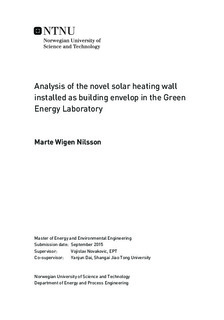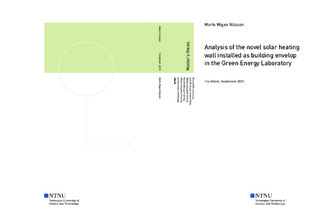| dc.description.abstract | This study looks at the use of façade integrated solar collectors in Norwegian buildings. One wall consisting of 0.25 m of timber framed insulation, and one wall consisting of 0.2 m insulation and 0.2 m concrete were tested. The U-value of both walls were 0.17 W/m2K. The solar collectors were mounted on these wall elements as a replacement of the external weather barrier. The investigations were conducted in TRNSYS and in a dynamic model describing the thermal performance of the façade integrated solar collectors, created at Shanghai Jiao Tong University. The complete solar collector system was designed according to recommended values from literature. A parametric study looking at the optimal design of the storage tank set point temperature, the ratio between the tank height and the diameter, the regulatory strategy, the flow rate, the water tank volume and the placement of the heat exchanger were conducted. Following was a heat pump installed in series with the solar collectors in the existing system. Different maximum evaporator inlet temperatures were tested to find the optimal system design.
The initial results showed that the heavy solar wall performed better than the lightweight solar wall. During the winter days, the heavy solar wall lead to a substantial reduction in the negative transmission compared to the conventional heavy wall. During the summer days, both of the solar walls introduced a positive transmission contribution, which may lead to overheating the building. The contribution was lowest for the heavy solar wall. When installing 6.68 m2 collector area in the TEK-10 building with the heavy wall configuration, the annual negative transmission was reduced by 84 % through the wall area with the installed collectors. A positive transmission of 39 kWh annually was also introduced. The parametric study revealed that the best design for system performance was not necessarily the optimal design for transmission energy savings. Related to transmission, lowering the flow rate showed the highest energy saving, of 1.5 kWh/m2 annually. In maximizing the collector performance, changing the regulatory strategy of the system led to an annual energy saving of 1.05 kWh/m2 floor area. This was also the efficiency measure that led to the biggest energy saving when accounting for both transmission and collector performance. The use of a series connected heat pump further improved the system performance. A maximum evaporator inlet temperature of 15 °C led to the highest energy saving of 30 % compared to the system without the heat pump, when accounting for both transmission and collector performance. | |

